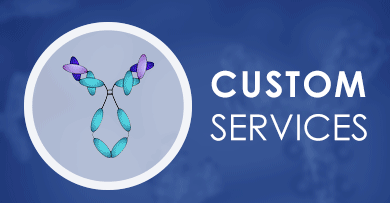 Loading...
Loading...

TPR
 Loading...
Loading...Anti-TPR Products
- Recombinant Mouse Anti-Human TPR Antibody (MOB-1817MZ)
-
- Species Reactivity: Human
- Type: Mouse antibody
- Application: IHC-P, WB
- PE-B*08:01/Human TPR (LPHNHTDL) MHC Tetramer (MHC-CN1285)
-
- Class: Class I
- Antigen: TPR
- Antigen Species: Human
- Peptide: LPHNHTDL
- Conjugate: PE
- APC-B*08:01/Human TPR (LPHNHTDL) MHC Tetramer (MHC-CN1286)
-
- Class: Class I
- Antigen: TPR
- Antigen Species: Human
- Peptide: LPHNHTDL
- Conjugate: APC
- FITC-B*08:01/Human TPR (LPHNHTDL) MHC Tetramer (MHC-CN1287)
-
- Class: Class I
- Antigen: TPR
- Antigen Species: Human
- Peptide: LPHNHTDL
- Conjugate: FITC
- B*08:01/Human TPR (LPHNHTDL) MHC Tetramer (MHC-CN1288)
-
- Class: Class I
- Antigen: TPR
- Antigen Species: Human
- Peptide: LPHNHTDL
- Conjugate: Unconjugated
- Mouse Anti-TPR Recombinant Antibody (MOB-1560z) (MOB-1560z)
-
- Species Reactivity: Human, Mouse, Rat
- Type: Mouse IgG2b, κ
- Application: ELISA, WB, IP, IF, IHC, FC
- Recombinant Anti-Human TPR Antibody Fab Fragment (MOB-1560z-F(E))
-
- Derivation: Mouse
- Species Reactivity: Human
- Type: Fab
- Application: IF, FACS, FuncS
- Recombinant Anti-Human TPR Antibody scFv Fragment (MOB-1560z-S(P))
-
- Derivation: Mouse
- Species Reactivity: Human
- Type: scFv
- Application: WB, Neut, FuncS
-
- Derivation: Phage display library
- Species Reactivity: Human
- Type: Rabbit IgG
- Application: ICC, IF, WB
- Anti-TPR Immunohistochemistry Kit (VS-0525-XY7473)
-
- Species Reactivity: Human
- Target: TPR
- Application: IHC
- Mouse Anti-TPR Recombinant Antibody (clone 2506W1147) (VS-0625-FY1252)
-
- Species Reactivity: Trypanosoma cruzi
- Type: Mouse IgG
- Application: ELISA
Can't find the products you're looking for? Try to filter in the left sidebar.Filter By Tag
Our customer service representatives are available 24 hours a day, from Monday to Sunday. Contact Us
For Research Use Only. Not For Clinical Use.
Background
Cancer-related genes, Disease related genes, Human disease related genes, Metabolic proteins, Plasma proteins, Potential drug targets, Transporters
Intracellular
Cell type enhanced (Spermatocytes)
Low immune cell specificity
Low cell line specificity
Interacts with IFI204 (via C-terminal region). Interacts with IFI203 (By similarity). Homodimer. Part of the nuclear pore complex (NPC). Associates with the XPO1/CRM1-mediated nuclear export complex, the Importin alpha/Importin beta receptor and the dynein 1 complex. Interacts (via C-terminal domain) with the KPNB1; the interaction occurs in a RanGTP-dependent manner. Interacts (via C-terminal regionand phosphorylated form) with MAPK1/ERK2 (via phosphorylated form); the interaction requires dimerization of MAPK1/ERK2 and increases following EGF stimulation. Interacts with MAPK3/ERK1; the interaction increases following EGF stimulation. Interacts (via coiled coil region) with NUP153; the interaction is direct. Interacts with HSF1; the interaction increases in a stress-responsive manner and stimulates export of stress-induced HSP70 mRNA. Interacts with huntingtin/HTT; the interaction is inhibited by aggregated huntingtin/HTT forms with expanded polyglutamine stretch. Interacts with MAD1L1 (via N-terminal region), MAD2L1, and TTK; the interactions occurs in a microtubule-independent manner. Interacts (via middle region) with DYNLL1. Interacts with DCTN1, dynein, NUP153 and tubulin. Interacts with MTA1.



